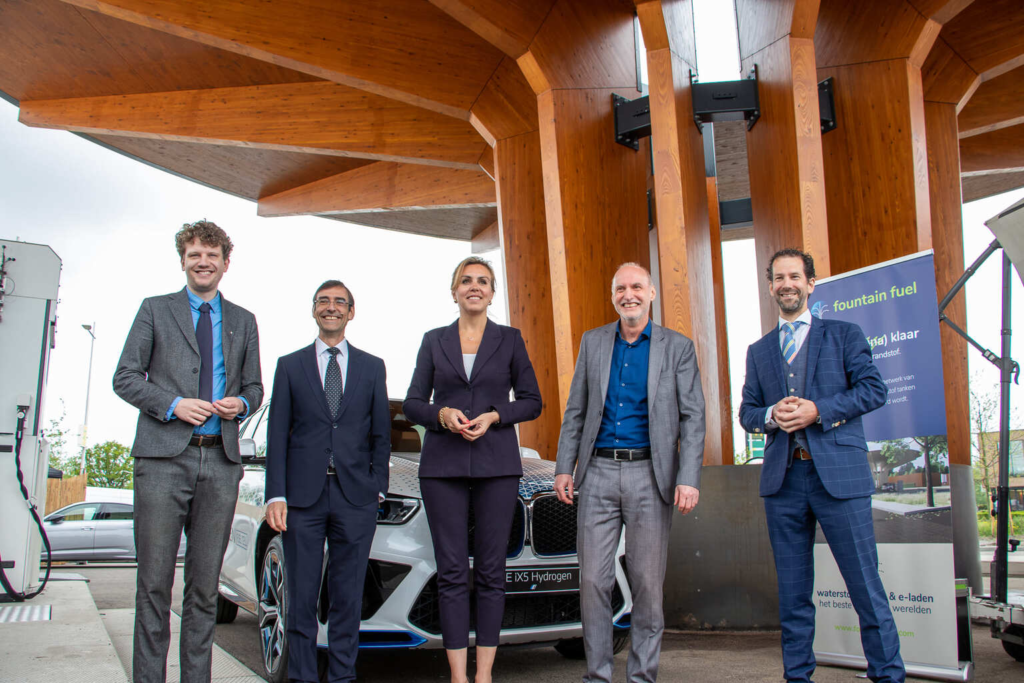
Fountain Fuel, a Dutch startup, has launched its first zero-emission energy station in Amersfoort, the Netherlands.
The station marks the start of the company’s national network of zero-emission energy stations, where large-scale hydrogen refuelling and electric charging will be combined. This innovative concept brings completely emission-free driving one step closer.
During the launch, the idea that hydrogen would be especially suitable for industrial applications or that hydrogen in mobility is only something for heavy transport was debunked. The speakers on stage highlighted the opportunities of hydrogen for mobile applications and what is still needed to accelerate this.
The formal opening was done by Vivianne Heijnen, State Secretary of the Ministry of Infrastructure and Water Management (I&W), who connected the brand new BMW iX5 Hydrogen to Fountain Fuel for the first time. According to Heijnen, “The Netherlands is fully engaged in an energy transition and hydrogen will be of indispensable value in this, also in mobility.” The government has therefore made 178 million euros available in the Climate Package for hydrogen applications on the road and inland shipping.
The role that hydrogen plays in the energy transition was discussed during the event, with attendees consisting of governments, entrepreneurs, OEMs, and financiers. Hydrogen in mobility was mentioned as a flywheel for this energy transition, with arguments such as speed of introduction, better margins, retention of knowledge in the Netherlands, lower costs for infrastructure, and relieving the electricity grid put forward.
Dr Juergen Guldner, hydrogen program manager at the BMW Group, explained the need for hydrogen in mobility, stating that “passenger cars with a fuel cell are an additional option for locally emission-free mobility in addition to battery-electric vehicles.” He expressed concerns about the increased reliance on raw materials for battery-electric vehicles and the available charging capacity.
The speakers from Linde Engineering and Allego highlighted the two sides of the coin at Fountain Fuel, with hydrogen and electric charging being two complementary techniques that can and must coexist. Linde provided insight into its vision on the global rollout of hydrogen filling stations and the need for quality and safety. Allego focused more specifically on the efficient use of limited space in the Netherlands and solutions to the nitrogen problem.
Stephan Bredewold, the co-founder of Fountain Fuel, emphasized the importance of a network, stating that “scaling up is of great importance for this. The switch to zero-emission driving will mainly succeed if there is sufficient tank infrastructure available – and vice versa.” Fountain Fuel aims to have started with 11 energy stations by 2025 and plans to have 50 Fountain Fuels by 2030, spread across the Netherlands.
After a few more weeks of testing, the location in Amersfoort will open to the public at the beginning of June. Locations in Rotterdam and Nijmegen are in preparation, and after the summer, Fountain Fuel expects to announce four new locations.
This innovative concept of combining large-scale hydrogen refuelling and electric charging brings completely emission-free driving one step closer. With the Netherlands fully engaged in an energy transition, hydrogen will be of indispensable value in this, also in mobility. The national network of zero-emission energy stations by Fountain Fuel will contribute to achieving the climate goals with zero-emission fuel.